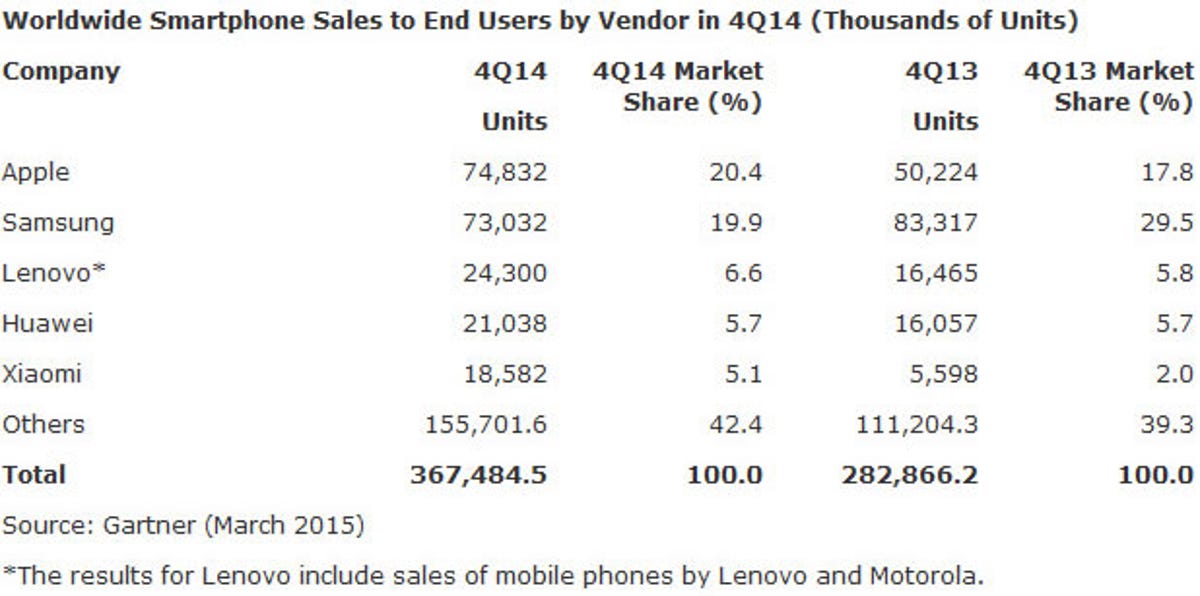
CNET
Apple scored the highest percentage of smartphone sales in the fourth quarter, courtesy of its new iPhones, according to a Gartner report released Tuesday.
For the final quarter of 2014, Apple took home a 20.4 percent share of worldwide smartphone sales, up from 17.8 percent during the same quarter in 2013. Over the same period, Samsung’s share of the smartphone market, on sales of 73 million units, plummeted to 19.9 percent from 29.5. percent.
Last quarter, Apple sold 74.8 million iPhones to achieve its best quarter ever, Gartner said. Apple’s phone lineup, now led by the iPhone 6 and iPhone 6 Plus, enjoyed heavy demand in the US and China, where sales surged 88 percent and 56 percent, respectively, according to Gartner. The new iPhones spurred many existing owners to upgrade but also convinced buyers looking for big-screened phones to consider Apple as an alternative to Android.
In January, researcher Strategy Analytics had described the fourth-quarter standings as a tie between Samsung and Apple, with both at 20 percent of the global smartphone market. But the momentum was the same — Apple trending upward and Samsung on the downswing.
Apple’s record quarter was a definitive sign that the move to bump up the display size of its smartphone paid off. The company had been losing market share and sales to Samsung, which offered larger-screened phones such as the Galaxy S5 and Galaxy Note. But the iPhone 6 wasn’t the only factor that helped Apple score the top spot. Samsung has also been hit on the low end by budget-friendly smartphones from Chinese vendors such as Xiaomi.
“Chinese vendors, such as Huawei and Xiaomi, are continuing to improve their sales in China and other overseas markets, increasing their share in the mid to low-end smartphone market,” Roberta Cozza, research director at Gartner, said in a press release. “Chinese vendors are no longer followers. They are producing higher quality devices with appealing new hardware features that can rival the more established players in the mobile phone market.”


Gartner
Over the fourth quarter, Lenovo took third place in the smartphone arena with a market share of 6.6 percent, followed by Huawei with 5.7 percent and Xiaomi with 5.1 percent. Lenovo’s 47.6 percent year-over-year gain in smartphone sales was boosted by its purchase of Motorola, which was factored into Gartner’s numbers.
For all of 2014, however, Samsung dominated the smartphone market with a 24.7 percent share, but that was down from 30.9 percent for the preceding year. The company had seen its market share and sales tumble throughout 2014.
“Samsung continues to struggle to control its falling smartphone share, which was at its highest in the third quarter of 2013,” Anshul Gupta, principal research analyst at Gartner, said. “This downward trend shows that Samsung’s share of profitable premium smartphone users has come under significant pressure.”
On Sunday, Samsung unveiled its new flagship lineup with the Galaxy S6 and Galaxy S6 Edge . The two phones aim to challenge the iPhone with their 5.1-inch high-resolution displays, metal frames, enhanced fingerprint scanner and an Apple Pay rival dubbed Samsung Pay. The S6 Edge ups the design ante even further with a screen that curves slightly on both the left and right sides.
Will the new Galaxy S6 phones help Samsung regain its mojo? Or will the iPhone 6 hang onto its leading market share? Stay tuned over the next couple of quarters to find out.


Now playing:
Watch this:
Prizefight: Battle of the Specs — Samsung Galaxy S6…
4:34



